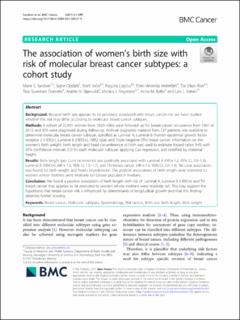| dc.description.abstract | Background: Because birth size appears to be positively associated with breast cancer risk, we have studied whether this risk may differ according to molecular breast cancer subtypes. Methods: A cohort of 22,931 women born 1920–1966 were followed up for breast cancer occurrence from 1961 to 2012, and 870 were diagnosed during follow-up. Archival diagnostic material from 537 patients was available to determine molecular breast cancer subtype, specified as Luminal A, Luminal B (human epidermal growth factor receptor 2 (HER2)-), Luminal B (HER2+), HER2 type, and Triple negative (TN) breast cancer. Information on the women’s birth weight, birth length and head circumference at birth was used to estimate hazard ratios (HR) with 95% confidence intervals (CI) for each molecular subtype, applying Cox regression, and stratified by maternal height. Results: Birth length (per 2 cm increments) was positively associated with Luminal A (HR = 1.2, 95% CI, 1.0–1.3), Luminal B (HER2+) (HR = 1.3, 95% CI, 1.0–1.7), and TN breast cancer (HR = 1.4, 95% CI, 1.0–1.9). No clear association was found for birth weight and head circumference. The positive associations of birth length were restricted to women whose mothers were relatively tall (above population median). Conclusion: We found a positive association of birth length with risk of Luminal A, Luminal B (HER2+) and TN breast cancer that appears to be restricted to women whose mothers were relatively tall. This may support the hypothesis that breast cancer risk is influenced by determinants of longitudinal growth and that this finding deserves further scrutiny | en_US |

